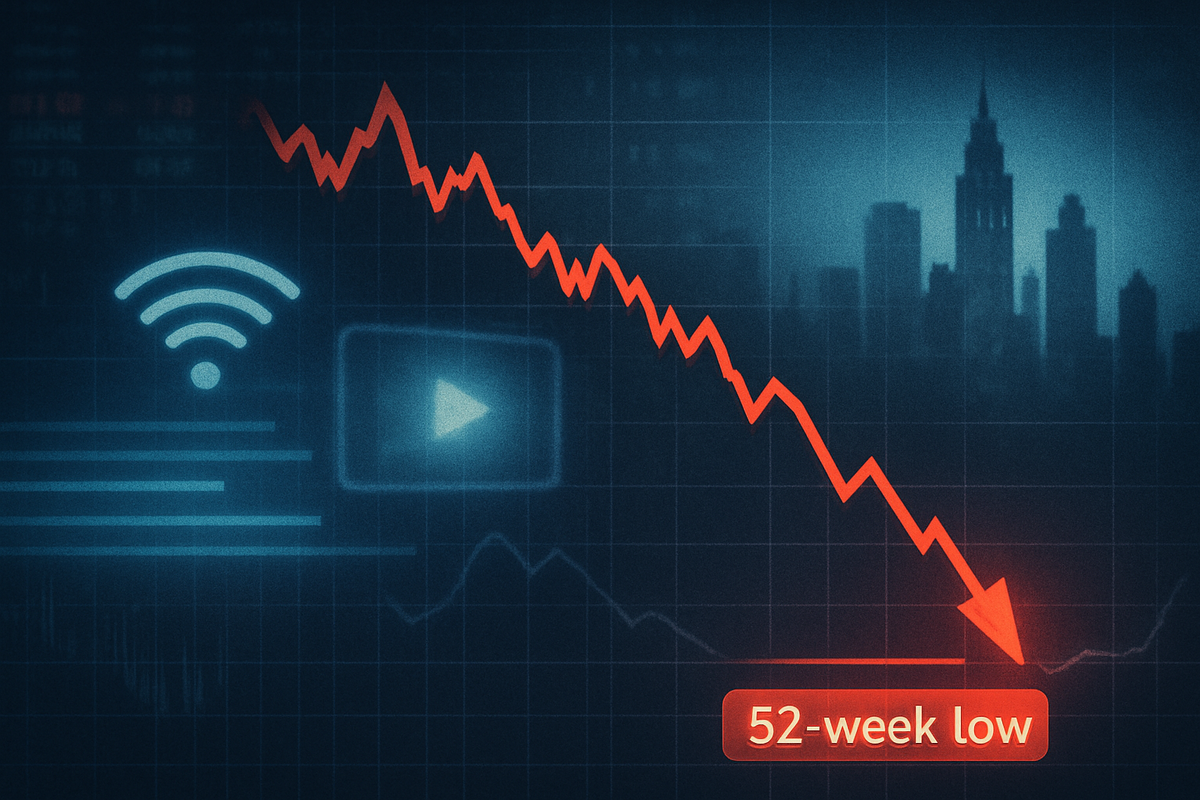Financial News
Comcast Hits 52-Week Low: Is the Media Giant Undervalued Amidst Industry Upheaval?

Philadelphia, PA – October 9, 2025 – Comcast Corporation (NASDAQ: CMCSA) recently saw its stock plunge to a 52-week low of $30.29 on October 9, 2025, a stark contrast to its 52-week high of $45.31. This significant downturn, reflecting a drop of over 20% in the past year, has sent ripples through the financial markets, prompting investors and analysts alike to question whether the diversified telecommunications and media giant is now undervalued, or if its struggles signal deeper, systemic challenges within its core businesses. The immediate implications point to a cautious market sentiment, though some metrics suggest a potential buying opportunity for value investors.
The decline is largely attributed to a confluence of factors, including intense competition in the broadband sector, accelerating cord-cutting, and a challenging advertising landscape. While the company is actively implementing strategic responses, including network upgrades and a significant leadership transition, the market's reaction highlights the urgent need for Comcast to demonstrate the effectiveness of these pivots.
Detailed Coverage of Comcast's Market Dip
Comcast's stock reached its 52-week low of $30.30 on October 7, 2025, a notable drop from its 52-week high recorded on October 31, 2024. This decline culminated from a challenging period marked by strategic shifts and intensifying market pressures. Leading up to this point, Comcast reported significant domestic broadband customer net losses, including 226,000 in Q2 2025, alongside video customer net losses of 325,000. These figures underscore the accelerating trend of "Cord-Cutting 2.0," where consumers are moving away from traditional cable bundles for both TV and internet services.
A critical event in the timeline was Comcast's (NASDAQ: CMCSA) Q2 2025 earnings report on July 31, 2025, which, despite solid financial results in some areas, revealed the extent of broadband and video subscriber attrition. In response to these industry headwinds, Comcast finalized the spin-off of its linear cable networks into a new entity, Versant Media, on October 6, 2025. This strategic divestiture aims to allow Comcast to sharpen its focus on higher-growth segments such as streaming (Peacock), broadband, and theme parks. Additionally, a significant leadership transition was announced on September 29, 2025, with Michael J. Cavanagh appointed Co-Chief Executive Officer, effective January 2026, signaling a future-focused leadership strategy.
Key players and stakeholders have reacted with a mix of concern and strategic adjustments. Analysts from institutions like BofA Securities and KeyBanc lowered their price targets, citing intense competition in broadband and weak subscriber growth expectations for Q3 2025. However, some, including The Goldman Sachs Group (NYSE: GS), maintained a "Buy" rating, pointing to Comcast's attractive P/E ratio and robust dividend yield. Institutional investors showed mixed sentiment, with First Merchants Corp reducing its stake while Clear Creek Financial Management LLC increased its holdings in Q2 2025. The initial market reaction was bearish, reflected in financial news reports and options market activities, yet some still acknowledged Comcast's underlying financial health and strategic efforts.
Market Impact: Winners and Losers
Comcast's stock hitting a 52-week low, largely driven by broadband subscriber losses, has significant implications for various players across the telecommunications and media landscape, creating both winners and losers in the competitive market.
In the broadband market, several companies stand to gain. Telecommunications giants like AT&T (NYSE: T) and Verizon (NYSE: VZ) are actively expanding their fiber-optic internet and fixed wireless access (FWA) services, aggressively capturing market share. AT&T, for example, reported a 19% year-over-year rise in fiber sales in Q1 2025. T-Mobile (NASDAQ: TMUS) is also a significant winner, leading the FWA market with substantial customer additions. These players are benefiting from consumers seeking more affordable and flexible internet options, directly impacting traditional cable providers. Conversely, traditional cable companies like Charter Communications (NASDAQ: CHTR) face similar, if not identical, competitive pressures. Industry experts predict that both Comcast and Charter could collectively lose over 1 million internet subscribers in 2025, highlighting a systemic challenge for the entire cable broadband sector.
In the streaming market, where Comcast operates Peacock, the struggles of a major player can create opportunities for others. The Walt Disney Company (NYSE: DIS) is a clear winner, having achieved profitability in its streaming business and further strengthening its position through the acquisition of Comcast's remaining stake in Hulu. Dominant players like Netflix (NASDAQ: NFLX) and Amazon Prime Video (NASDAQ: AMZN) continue to hold significant market shares, benefiting from established subscriber bases and continuous investment in original content. While Peacock has shown subscriber growth and narrowing losses, its smaller market share and continued unprofitability make it vulnerable. Any reduced investment from a financially strained Comcast could further benefit its more established streaming rivals.
Beyond direct competitors, the event impacts the broader media and content industries. A weaker Comcast could reduce competition in the theme park sector, particularly in Florida, where Universal's Epic Universe park is set to open in May 2025, directly rivaling Disney World (NYSE: DIS). If Comcast pulls back on content spending for its NBCUniversal segment, it could create opportunities for other studios and content producers to acquire talent or intellectual property. The broader advertising market, already shifting from linear TV to streaming, might also see ripple effects, though demand for sophisticated advertising technology for digital platforms is likely to remain robust. Overall, Comcast's downturn underscores an accelerating transformation across the telecommunications and media sectors, rewarding agility and innovation while challenging traditional business models.
Wider Significance of the Decline
Comcast's stock hitting a 52-week low is not an isolated event but a potent symbol of profound shifts occurring across the telecommunications and media industries. This downturn fits squarely into broader trends, primarily the "Cord-Cutting 2.0" phenomenon, which sees consumers abandoning not just traditional pay-TV but also traditional cable internet bundles in favor of more agile and often cheaper alternatives. Comcast's loss of hundreds of thousands of broadband and TV subscribers in recent quarters is a clear manifestation of this trend, driven by the aggressive expansion of 5G Home Internet from wireless carriers and fiber-optic services from companies like AT&T (NYSE: T) and Google Fiber.
The ripple effects extend across the ecosystem. Competitors in wireless (Verizon (NYSE: VZ), T-Mobile (NASDAQ: TMUS), AT&T) and fiber (AT&T Fiber, Google Fiber) are direct beneficiaries, capitalizing on Comcast's subscriber attrition and expanding their market presence. Traditional cable providers like Charter Communications (NASDAQ: CHTR) face similar pressures, indicating a sector-wide challenge that necessitates rapid adaptation. Beyond direct competition, the event highlights the ongoing digital transformation of the industry, with a strong emphasis on cloud adoption, virtualized networks, and AI integration for efficiency and customer service. In media, the fragmentation of content consumption continues, forcing companies to innovate their streaming strategies and content offerings to capture and retain audiences.
Regulatory and policy implications also play a significant role. The period around October 2025 is marked by a potential deregulatory push, particularly if there's a change in administration, which could lead to loosened FCC ownership rules and increased industry consolidation. Simultaneously, there's enhanced FCC scrutiny of foreign ownership in telecommunications and a growing focus on cybersecurity and consumer transparency. These regulatory shifts could either alleviate some pressures on large players or introduce new compliance burdens, depending on their specific nature.
Historically, the current challenges draw parallels to the telecoms crash of 2001, which followed the dot-com bubble burst. That period saw massive declines in telecom valuations, widespread bankruptcies, and job losses, fueled by overvaluation and overbuilding of infrastructure. While the current situation isn't purely speculative, it shares the theme of intense competition and the vulnerability of traditional revenue streams to new technological alternatives. However, "Cord-Cutting 2.0" is a more fundamental shift in consumer behavior, driven by technological evolution rather than purely speculative investment, making the current transformation perhaps more ingrained and long-lasting for the industry.
What Comes Next for Comcast
Comcast's path forward from its 52-week low will be defined by its ability to execute on strategic pivots and adapt to the evolving market. In the short term, the company is poised for continued volatility, with its Q3 2025 earnings report on October 30, 2025, being a critical event. Investors will be scrutinizing broadband subscriber numbers for any signs of stabilization, as well as the financial trajectory of its streaming service, Peacock. The initial ramp-up of Universal's Epic Universe theme park, set to open in May 2025, is also expected to provide a short-term boost to its Experiences segment. Leadership changes, with Michael Cavanagh becoming Co-CEO in January 2026, are anticipated to bring fresh operational focus and stability.
Long-term possibilities for Comcast hinge on the successful execution of its multi-pronged strategy. The company is heavily investing in its broadband network, deploying fiber and DOCSIS 4.0 technology to deliver multi-gigabit symmetrical speeds, aiming to counter competitive threats from fiber and 5G FWA. Its aggressive expansion in Xfinity Mobile, leveraging its extensive Wi-Fi network, represents a significant growth opportunity. Comcast is also doubling down on Peacock's content strategy, particularly with live sports, to differentiate the service and drive subscriber growth. The spin-off of legacy cable networks into Versant Media is a strategic move to streamline operations and allow for a leaner, more focused company.
Potential scenarios range from a successful transformation, where DOCSIS 4.0 provides a strong competitive offering, Xfinity Mobile continues its rapid expansion, and Peacock achieves profitability, leading to a significant recovery in stock value. Conversely, stagnation or decline could occur if broadband losses accelerate beyond mitigation efforts and Peacock fails to turn a profit, putting long-term growth at risk. A hybrid outcome is also possible, where some segments perform well (e.g., wireless, theme parks) while others continue to face challenges, allowing the company to maintain strong free cash flow and shareholder returns through dividends and buybacks, albeit with modest overall growth. The recent rate cuts by the Federal Reserve (September 2025) could also offer a macroeconomic tailwind, potentially reducing debt costs and increasing consumer spending.
Comprehensive Wrap-up and Investor Outlook
Comcast's journey through its 52-week low is a vivid illustration of the profound structural changes impacting the telecommunications and media industries. The key takeaways underscore that traditional revenue streams are under immense pressure, demanding rapid and effective strategic pivots from established players. While the company faces significant headwinds from intensified competition in broadband and the ongoing cord-cutting phenomenon, its underlying financial strength, characterized by an attractive P/E ratio, robust dividend yield, and strong free cash flow, suggests a degree of resilience that could enable future growth.
Moving forward, the market for Comcast and its industry will be defined by a relentless pursuit of innovation and adaptation. Comcast's strategic responses—including massive investments in network upgrades (fiber and DOCSIS 4.0), aggressive expansion in Xfinity Mobile, and a focused content strategy for Peacock—are critical to its future success. The spin-off of legacy cable networks and the incoming co-CEO leadership signify a decisive shift towards a leaner, more growth-oriented enterprise. However, the success of these initiatives against formidable competitors like AT&T (NYSE: T), Verizon (NYSE: VZ), and T-Mobile (NASDAQ: TMUS) will be paramount.
The lasting impact of these developments will hinge on Comcast's ability to effectively execute its diversified strategy. If it can stabilize broadband subscriber trends, accelerate mobile growth, and guide Peacock to profitability, the company may indeed prove to be undervalued at its current levels. The "free" valuation of its theme parks by some analysts, coupled with its consistent dividend payments, presents a compelling argument for long-term investors willing to weather the current volatility.
Investors should closely watch several key indicators in the coming months. The Q3 2025 earnings report on October 30, 2025, will provide crucial insights into broadband subscriber performance and the initial effectiveness of strategic changes. Continued monitoring of Xfinity Mobile's growth, Peacock's path to profitability, and updates on the Epic Universe theme park will be essential. Furthermore, any changes to Comcast's shareholder return policy and the evolving strategic vision under the new co-CEO leadership will offer important clues about the company's future trajectory. Comcast's ability to navigate these complex industry shifts will determine whether its current low marks a temporary setback or a more enduring challenge.
This content is intended for informational purposes only and is not financial advice.
More News
View More




Recent Quotes
View More
Quotes delayed at least 20 minutes.
By accessing this page, you agree to the Privacy Policy and Terms Of Service.



